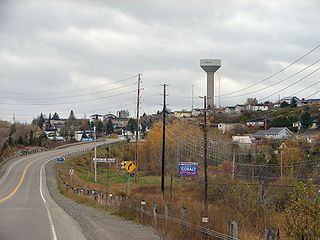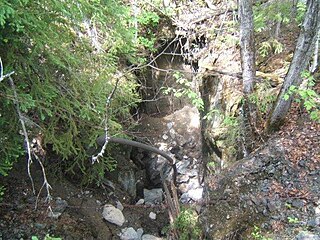Related Research Articles

The Ontario Northland Railway is a Canadian railway operated by the Ontario Northland Transportation Commission, a provincial Crown agency of the government of Ontario.

Cobalt is a town in Timiskaming District, Ontario, Canada. It had a population of 1,118 at the 2016 Census. The population is now closer to 943.

Agnico Eagle Mines Limited is a Canadian-based gold producer with operations in Canada, Finland, Australia and Mexico and exploration and development activities extending to the United States. Agnico Eagle has full exposure to higher gold prices consistent with its policy of no-forward gold sales. As of 2017, it has paid a cash dividend every year since 1983.
The Nipissing Central Railway (NCR), sometimes known as the Temiskaming Streetcar Line, is a former interurban streetcar system connecting New Liskeard, Haileybury and Cobalt on the western bank of Lake Temiskaming in northern Ontario from 1910 to 1935. As the line had a federal charter, the operating company continues to be used to operate the Ontario Northland Railway freight spur line between Swastika, Ontario and Rouyn-Noranda, Quebec, avoiding the need to re-charter either end in its respective provinces.

Temagami, formerly spelled Timagami, is a municipality in northeastern Ontario, Canada, in the Nipissing District with Lake Temagami at its heart.

The Porcupine Gold Rush was a gold rush that took place in Northern Ontario starting in 1909 and developing fully by 1911. A combination of the hard rock of the Canadian Shield and the rapid capitalization of mining meant that smaller companies and single-man operations could not effectively mine the area, as opposed to earlier rushes where the gold could be extracted through placer mining techniques. Although a number of prospectors made their fortune, operations in the area are marked largely by the development of larger mining companies, and most people involved in the mining operations were their employees.

Michael John O'Brien was a railway builder, industrialist and philanthropist. He was named to the Senate of Canada in 1918. He was a founder of the town of Renfrew, Ontario.
The Cobalt silver rush was a silver rush in Ontario, Canada that began in 1903 when huge veins of silver were discovered by workers on the Temiskaming and Northern Ontario Railway (T&NO) near the Mile 103 post. By 1905 a full-scale silver rush was underway, and the town of Cobalt, Ontario sprang up to serve as its hub. By 1908 Cobalt produced 9% of the world's silver, and in 1911 produced 31,507,791 ounces of silver. However, the good ore ran out fairly rapidly, and most of the mines were closed by the 1930s. There were several small revivals over the years, notably in World War II and again in the 1950s, but both petered out and today there is no active mining in the area. In total, the Cobalt area mines produced 460 million ounces of silver.
Silver Centre is a ghost town in Timiskaming District, Northeastern Ontario, Canada, situated in South Lorrain Township. It is located approximately 35 km (22 mi) south of North Cobalt, and 3 km (1.9 mi) west of Highway 567. Silver Centre was a secondary camp to the great silver fields of Cobalt, discovered in 1903. There are no current residents in Silver Centre. It is still an active mineral field and does at times have active mineral exploration.

Beanland Mine, also known as Clenor Mine, is an abandoned surface and underground mine in Northeastern Ontario, Canada. It is located about 1 km (0.62 mi) west of Arsenic Lake and 4 km (2.5 mi) northwest of the town of Temagami in central Strathy Township. It is named after Sydney Beanland, who first claimed the mine site in the 1920s and was a director for the mine from 1937 to 1938.
The Buffalo Mine is an abandoned silver mine located in Cobalt, Ontario, Canada.
The Coniagas Mine is an abandoned silver mine in Cobalt, Ontario, Canada, located on the western side of Cobalt Lake. The mine was discovered in May 1903 by William Griffith Trethewey. The claim was sold to R. W. Leonard of St. Catharines Ontario and placed into production in 1904. The mine and the associated Coniagas Reduction Works of St Catharines operated until 1924 when known reserves were exhausted. The Coniagas Group was noted in mining circles being involved in the establishment of the Coniaurum Mine in Timmins and the Sturgeon River Mine in Geraldton Ontario.

The Northland Pyrite Mine, also known as James Lake Mine, Rib Lake Mine, Harris Mine or simply Northland Mine, is an abandoned underground mine in Northeastern Ontario, Canada, located on the southwestern shore of James Lake in Best Township of Temagami. It was operated by the Northland Mining Company during the early 1900s with the construction of a 91 m (299 ft) shaft and many open-cuts north of the shaft. Minerals present at the mine include chalcopyrite, pyrite and pyrrhotite, deposited in Precambrian volcanic rock of the Canadian Shield.
Barton Mine, also known as Net Lake Mine, is an abandoned surface and underground mine in Northeastern Ontario, Canada. It is located about 0.50 km (0.31 mi) north of the Temagami Arena in Temagami North and just east of the Ontario Northland Railway in northwestern Strathy Township. Dating back to the early 1900s, it is one of the oldest mines in Temagami. Barton was the site of a fire in the early 1900s, after which it never had active mining again.

Keeley-Frontier Mine is a large abandoned mine in the ghost town of Silver Centre, Northeastern Ontario, Canada. It consists of two underground mines that were sunk 1,455 ft (443 m) below the surface. Keeley Mine was discovered in 1907 while Frontier Mine was constructed in 1921. The 8th level of the Keeley Mine connected with the 6th level of the Frontier Mine in 1962, creating the two compartment Keeley-Frontier Mine. In 1965, Keeley-Frontier Mine closed with a total production of 19,000,000 oz (540,000,000 g) of silver, 3,300,000 lb (1,500,000 kg) of cobalt, 27,000 lb (12,000 kg) of nickel and 10,000 lb (4,500 kg) of copper.
Temagami-Lorrain Mine is an abandoned surface and underground mine in Northeastern Ontario, Canada. It is located about 10 km (6.2 mi) northeast of the town of Temagami near Sauvé Lake in central Cassels Township. It is named after the Temagami-Lorrain Mining Company, which carried out work on the property in the early 1900s.
The Rabbit Lake Occurrence is a mineral showing near the southeastern shore of Rabbit Lake in Northeastern Ontario, Canada. Situated in northeastern Askin Township, the occurrence contains primary cobalt, nickel and gold mineralization but silver is also present. It has a width of 46 cm (18 in) and is hosted by a fracture zone in conglomerate-greywacke of the Huronian Supergroup.
Alfred "Fred" La Rose, also known as "Fred Rose" and "Frederick LaRose", was a blacksmith from Quebec who discovered silver on September 15, 1903 at the future site of Cobalt, Ontario. He is often referred to as the "Father of Cobalt," an unofficial title shared by the province of Ontario's first geologist, Dr. W. G. Miller.
Kirkland Lake Gold Inc. was a Canadian gold mining company, based in Toronto, that owned and operated several gold mines in Canada and Australia.
References
- ↑ Tailings of the Cobalt Area
- ↑ Pain, S.A. (1960). Three Miles of Gold. Toronto: The Ryerson Press. pp. 2–3.
- ↑ Barnes, Michael (1986). Fortunes in the Ground. Erin, Ontario: The Boston Mills Press. p. 17,36,61–63,66. ISBN 091978352X.